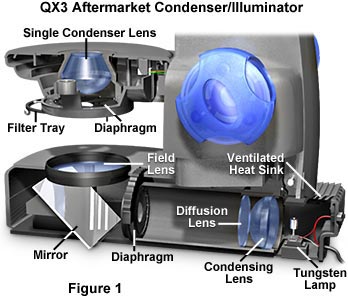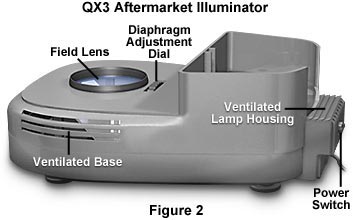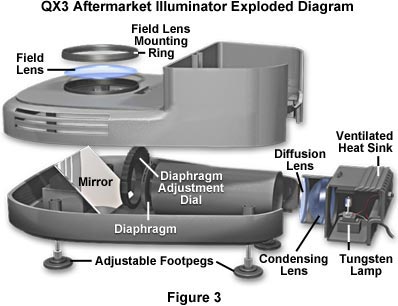Advanced Condenser Systems
Abbe Condenser Design Number Seven
In a modern microscope, the substage condenser functions to gather light from the tungsten-halide lamp and concentrates it into an inverted cone of light that illuminates the specimen with parallel beams of uniform intensity from all azimuths over the entire viewfield.

The Abbe-style condenser illustrated in Figure 1 constitutes the simplest and least corrected condenser design, which takes advantage of modern plastic optics technology by substituting a single lens for the two optical lens elements commonly found in Abbe condensers. This lens will produce an image of the illuminated field diaphragm showing signs of optical aberration. When viewed through the eyepieces (or interactive software), the image of the field diaphragm is not sharp and is surrounded by blue and red color at the edges. As a result of minimal optical correction, the Abbe-style condenser is suited mainly for routine observation with objectives of modest numerical aperture and magnification, such as found on the Intel Play QX3 Computer Microscope.
This condenser design is a prototype intended to replace the stock mixing chamber beneath the stage on the QX3 microscope. After removing the mixing chamber by loosening the two mounting screws, the condenser is attached by similar brackets to the same mounting flange. The stock QX3 tungsten lamp is replaced simultaneously with the mixing chamber.
The microscope base features an efficient multi-component illumination system that is modeled after those found in modern research microscopes. Light from the tungsten (or tungsten-halide) lamp is concentrated through a condensing lens before passing through a diffuser and the field diaphragm. Next, the light is reflected into the bottom of the condenser through an angled mirror and a field lens. This design will replace the stock QX3 microscope base.

An exterior view of the advanced QX3 microscope base is illustrated in Figure 2 and an exploded view showing all components is presented in Figure 3. The design can be executed in aluminum or polymer, with material candidates including acrylonitrile-butadiene-styrene (ABS), polystyrene, and polypropylene. Lens materials can be either polymethylmethacrylate (PMMA) or glass, and this choice will affect the major details of lens architecture and design.

The condenser aperture diaphragm can also be constructed of plastic or metal, depending upon lamp choice. As lamp power is increased, a corresponding increase in heat generated by the lamp will necessitate construction of surrounding materials of increasingly higher heat tolerance. The field lens should be constructed of glass to avoid distortion and optical artifacts that may be introduced by heat from the lamp filament. Reflector and heat sink construction materials should be aluminum. The tungsten or tungsten-halide lamp is powered by an external direct current (DC) power supply that draws current from a 120-volt source.
BACK TO ADVANCED CONDENSER SYSTEMS
